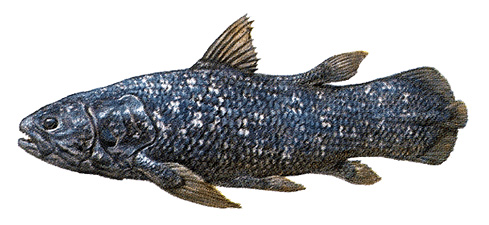Coelacanth << SEE luh kanth >> is a primitive type of fish found in the Indian Ocean. Some coelacanth fossils date from more than 300 million years ago. Scientists believed these fish had been extinct for 80 million years until a coelacanth was caught off the coast of South Africa in 1938. Since then, many more coelacanths have been caught in the waters of the western Indian Ocean around the Comoros archipelago (group of islands). In 1997, another population of coelacanths was discovered in the waters around Indonesia. Scientists have determined that the two populations are different species.
Coelacanths are members of an ancient group of lobe-finned fishes known as sarcopterygians. Lungfishes are the only other surviving members of this group. The sarcopterygians gave rise to tetrapods, the first vertebrates (animals with backbones) to live on land. Thus, all amphibians, birds, mammals, and reptiles descended from sarcopterygian fish. See Fish (The Age of Fishes).

Coelacanths are dark brown to blue-gray. They grow to more than 6 feet (1.8 meters) long and weigh up to 210 pounds (95 kilograms). Coelacanths have muscular, limblike fins on the underside of their body. They feed on squid and various fishes. Unlike most fish, the female coelacanth does not lay eggs. She gives birth to live young.
